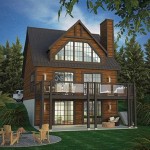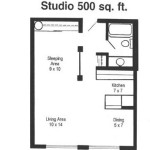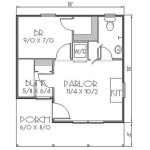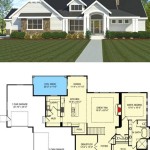Exploring the Versatility of 1-Bedroom Home Floor Plans
One-bedroom home floor plans represent a significant sector of the housing market, appealing to a diverse demographic including single occupants, young professionals, couples, and downsizing retirees. These floor plans offer a balance between affordability and functionality, providing a designated living space while minimizing square footage. The design and layout of a one-bedroom home are critical factors in maximizing space utilization and creating a comfortable living environment.
The increasing popularity of urban living and a growing emphasis on sustainable lifestyles have further contributed to the demand for well-designed one-bedroom units. These homes are often situated within apartment complexes, condominiums, or smaller, detached dwellings. Effective planning is essential to ensure that the floor plan caters to the specific needs and lifestyle of the occupant.
This article explores the key considerations in designing and selecting a one-bedroom home floor plan, examining different layout configurations and highlighting strategies to optimize space and functionality. It also discusses the importance of considering individual needs and preferences when customizing a one-bedroom dwelling.
Understanding Common 1-Bedroom Floor Plan Configurations
Numerous floor plan configurations exist for one-bedroom homes, each offering unique advantages and disadvantages. Some of the most common arrangements include linear plans, open-concept designs, and variations incorporating alcoves or dens. The choice of layout will significantly impact the overall feel and functionality of the home.
Linear plans typically feature a hallway connecting the entrance to the bedroom, bathroom, and living area. While this provides a degree of separation between rooms, it can also result in a narrow, potentially cramped feel. Open-concept designs, on the other hand, eliminate or minimize walls between the living room, dining area, and kitchen, creating a more spacious and airy environment. These designs are particularly well-suited for smaller units, as they maximize the perception of space.
Floor plans incorporating alcoves or dens offer additional flexibility. Alcoves can be used as sleeping areas, home offices, or reading nooks, while dens provide a separate space for work or relaxation. These additions can be particularly valuable for individuals who require a dedicated workspace or prefer a more defined separation between living and sleeping areas.
Beyond the basic layout, the placement of key features such as windows, doors, and closets plays a significant role in the usability of the space. Maximizing natural light through strategically positioned windows can enhance the sense of openness and improve the overall ambiance of the home. Carefully planned closet space is crucial for maintaining organization and minimizing clutter, particularly in smaller units.
The orientation of the bedroom relative to the living area is another important consideration. Some floor plans position the bedroom near the entrance for increased privacy, while others place it closer to the living area for ease of access. The ideal arrangement will depend on the individual's preferences and lifestyle.
Maximizing Space and Functionality in a Small Footprint
One of the primary challenges in designing a one-bedroom home is maximizing space within a limited footprint. This requires careful consideration of furniture selection, storage solutions, and the strategic use of design elements. Multifunctional furniture, such as sofa beds, storage ottomans, and dining tables with folding leaves, can significantly enhance the versatility of the space.
Vertical storage solutions, such as bookshelves that extend to the ceiling and wall-mounted cabinets, can help to free up floor space and create a more organized environment. Utilizing the space under beds and sofas for storage can also be an effective strategy for maximizing available space. Shelving units installed above doorways or in hallways can provide additional storage without encroaching on living areas.
Mirrors can be used strategically to create the illusion of greater space and to reflect natural light, making the room appear brighter and more open. Light-colored paint and flooring can also contribute to a more spacious feel. Avoiding clutter and maintaining a minimalist aesthetic are essential for minimizing visual clutter and creating a sense of calm and order.
The efficient utilization of kitchen space is particularly important in a one-bedroom home. Compact appliances, such as apartment-sized refrigerators and combination washer-dryer units, can help to save space. Utilizing wall-mounted shelving and magnetic knife racks can further optimize kitchen storage. A well-organized pantry can also help to maximize the usability of the kitchen space.
In the bathroom, consider using a wall-mounted sink and toilet to free up floor space. A shower curtain instead of a glass door can also save space. Utilizing over-the-door organizers and shelving units can further maximize storage in the bathroom.
Adapting the Floor Plan to Individual Needs and Preferences
While standard one-bedroom floor plans offer a basic framework, it is essential to adapt the design to individual needs and preferences. Factors such as lifestyle, work habits, and personal style should all be considered when customizing the floor plan. For example, an individual who works from home may require a dedicated office space, while someone who enjoys entertaining may prioritize a larger living area.
If the occupant is an avid cook, a larger kitchen or upgraded appliances may be desirable. If the individual is a book lover, ample bookshelf space will be a priority. If the occupant has a pet, considerations should be made for pet-friendly flooring and designated areas for pet food and toys.
Accessibility is another important consideration, particularly for individuals with mobility limitations. Wider doorways, grab bars in the bathroom, and barrier-free showers can enhance accessibility and improve the overall usability of the home. Smart home technology, such as voice-activated lighting and appliances, can also be beneficial for individuals with disabilities.
Personal style should also be reflected in the design of the home. The choice of colors, materials, and furnishings can significantly impact the overall ambiance of the space. Creating a mood board or consulting with an interior designer can help to ensure that the design reflects the occupant's personal aesthetic.
Ultimately, the optimal one-bedroom floor plan is one that effectively balances space, functionality, and personal preferences. Careful planning and attention to detail are essential for creating a comfortable and livable home that meets the unique needs of the occupant.
Furthermore, consider the future resale value of the property when making design decisions. While personalizing the home is important, it is also important to avoid making changes that could negatively impact the resale value. Neutral color palettes, durable materials, and timeless designs are generally considered to be more appealing to a wider range of buyers.
Engaging with an architect or interior designer experienced in designing small living spaces is advisable. These professionals offer valuable insights and can assist in maximizing the potential of the available space while ensuring the design aligns with both the occupant’s lifestyle and budgetary constraints.

Ranch Style House Plan 1 Beds Baths 896 Sq Ft 771 One Bedroom Plans Small Floor

1 Bedroom House Plan Examples

1 Bedroom Apartment Plan Examples

Small 1 Bedroom House Plan Plans Tiny Floor Guest

One Bedroom House Plans For Starter Homes Ck

Small House Plan 1 Bedroom Home 24x24 Floor Tiny

Rustic Craftsman House Floor Plans 1 Story Bedroom 700 Sq Ft Small One

1 Bedroom House Plan Examples

1 Bedroom House Plans Truoba Architect

International House 1 Bedroom Floor Plan Top View One Plans








